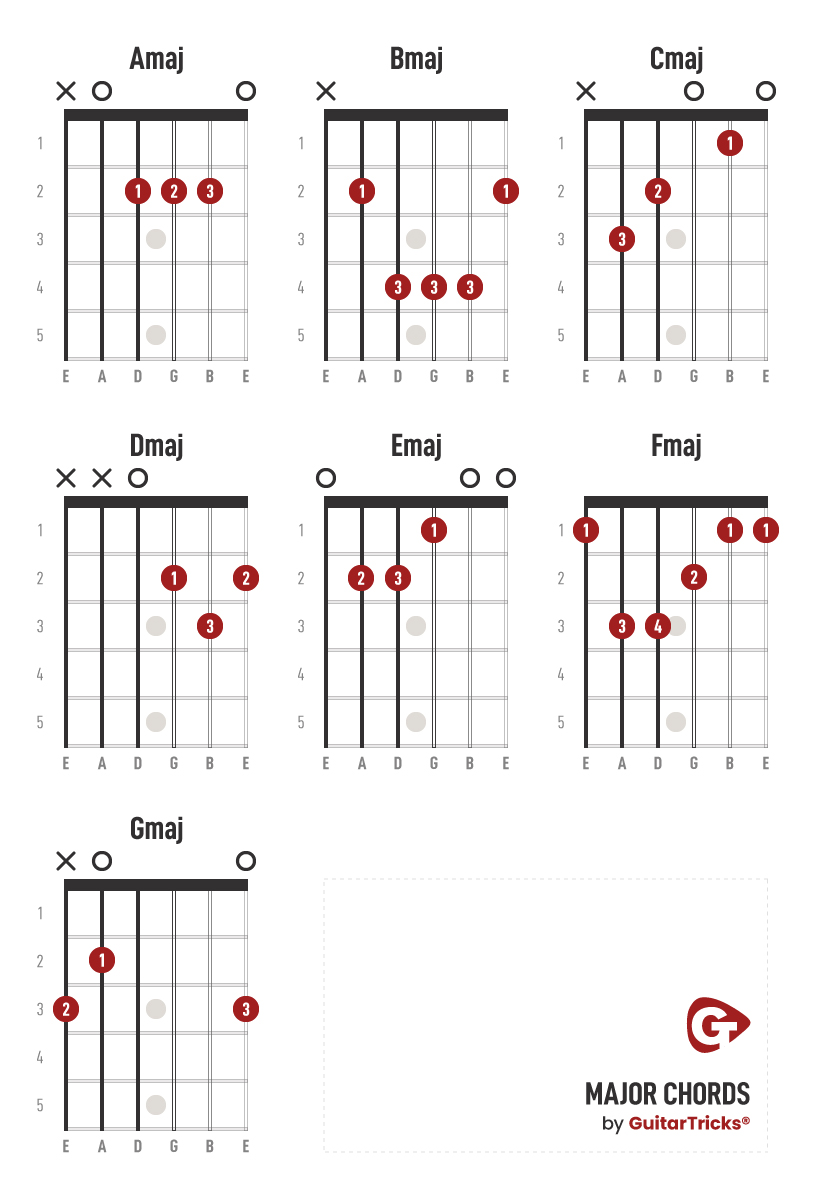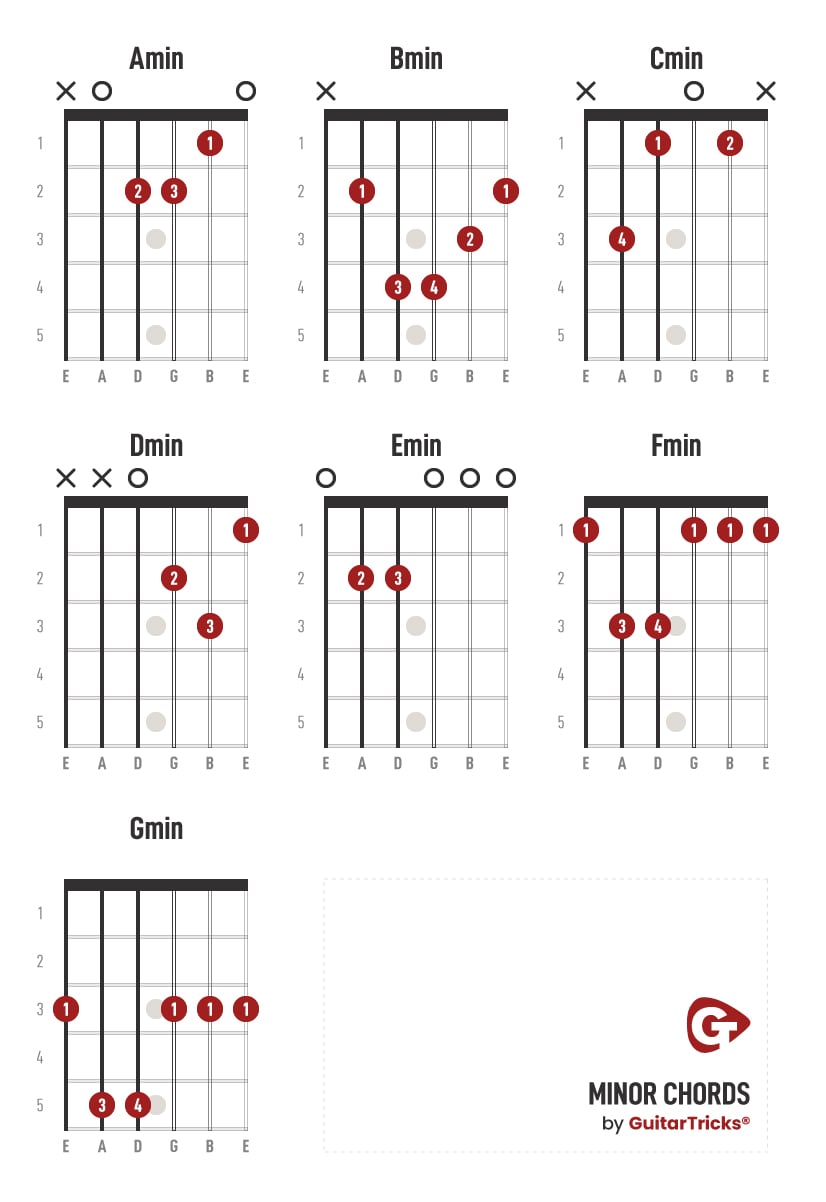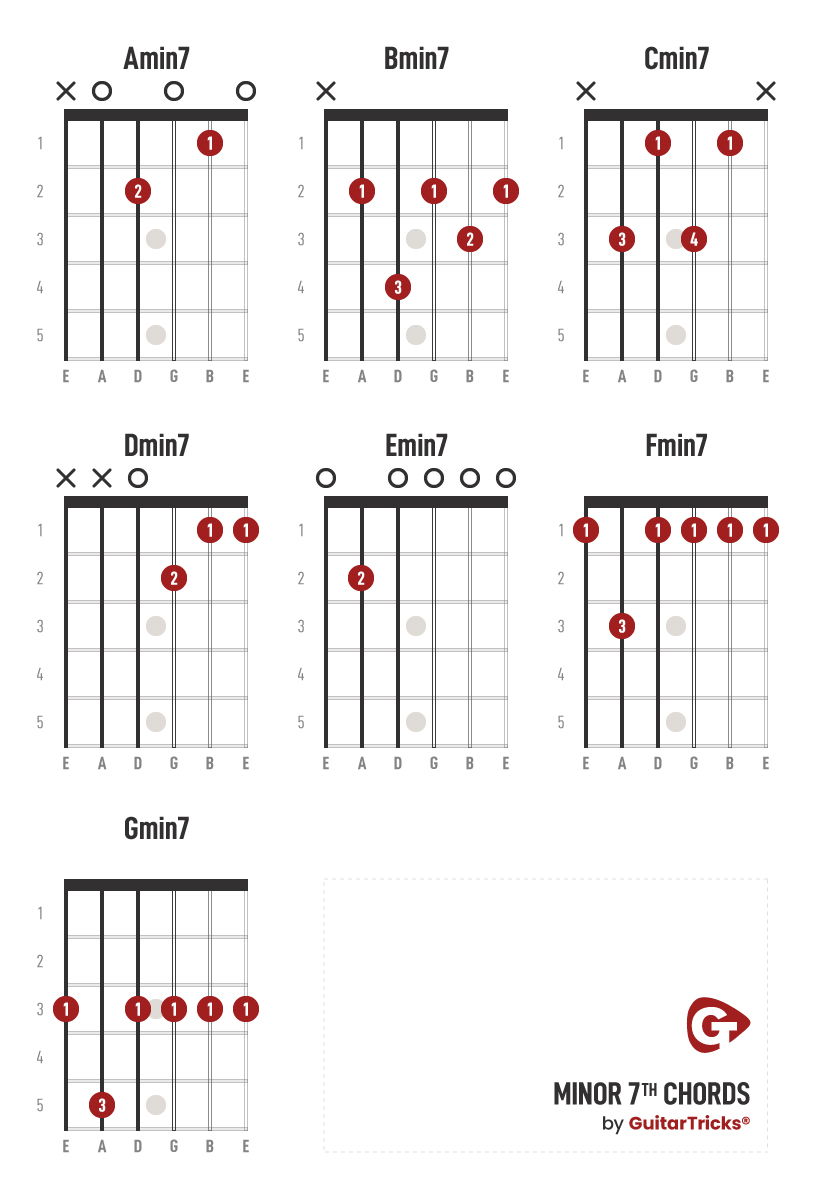By Shawn Leonhardt
The easiest chords to play on the guitar are open chords.
Open chords will most likely be the first thing you pick up when learning to play guitar.
This is where the chords are played in 'first position' closest to the nut and you use strings that are not fretted - i.e. open.
The important part to remember is that these open strings cannot be touched by your fingers or it will cause dead and unpleasant sounds.
When you first start playing, go slow and focus on what you can do, saving the harder chords for when you get better!
Here is a quick look at how to play all open chords.
Open Chords Vs. Barre Chords
Guitars are chordophones which means they produce sound by fretting a string stretched across two points.
Each time you place your finger right before a fret and press down you are effectively changing the nut and note position.
Guitar chords are stacked notes from a scale that when played together form a consonant or dissonant sound depending on the notes used.
A power chord is not technically a chord as it is only made up of the 1st and 5th notes of the scale; a regular major chord however has the formula 1-3-5.
Try fretting an open G at 320003, those notes are G-B-D-G-B-G, the G is the 1st, B the 3rd, and D the 5th.
Notice the 3 open strings, we can also form a G at the 3rd fret with 354433 which is G-D-G-B-D-G.
Both are the G major chord, but the latter is a barre chord.
Any chord that has an open string is considered an open chord, and while there are far too many to include in this article, we will show you the most common.
Each time you learn a new chord make sure that every string is playing clearly and check the notes!
By studying the makeup it will be easier to memorize your fretboard and get ahead in music theory.
Major Open Chords

The first major chords to learn should be the CAGED system shapes, as these will later translate into your barre chords.
And when learning these it is important to study specific orders, chord progressions are how songs work so it’s wise to keep your open chords grouped in these patterns.
We know open G major, so next let’s look at C major X32010.
Notice we mute (X) the low string here so our bass note is a C.
You can play a C/E chord as 032010 and it will still sound ok as that is an inversion of C.
The D major chord has two muted strings XX0323m, but you can only play X00323 as that is a D/A inversion.
Adding the open E will make it sound off as the E is not in the D major chord.
Try not to let this confuse you and keep your focus on the open shapes of G-C-D.
Practice slowly playing them in this order until there are clean changes, use a metronome to count measures of 4 and change your chords as you get better.
Congrats! Now you can learn tons of songs with just the G-C-D!
Now play the open chords A major X02220 and E Major 022100, these will make it so you can play the chord progressions of A-D-E and E-A-D-A.
Notice the latter one has a more rocking vibe than A-D-E, this is because our intervals and mode has changed leading to a different kind of feeling.
Minor Open Chords

Now a minor chord has the formula of 1-b3-5, the 3rd degree is flattened which gives the sound a sad or low impression unlike the major chords.
First we learn E minor which is 022000, compare that with the E major above by putting your finger off and on 1st fret on the G string.
That b3 will take the song from uplifting to brooding!
Next try an A minor which is X02210, again it is just one string change since we are moving the 3rd degree one semitone.
If we play 002210 then it is an Am/E and will sound ok in that inversion.
Another open minor is the D minor which is XX0231, compare that to the D major and make sure your muted strings are silent and your open strings all ring out as you play.
Now with these open minor guitar chords you have some more progressions available like the jazz Dm-G-C, the minor Am-Dm-Em, or even the doo wop G-Em-C-D.
With just these simple open chords you can now play most popular music!
7th Open Chords

We can continue to build on our 1-3-5 or 1-b3-5 chord formulas by adding more notes in, the most common is the 7th scale degree.
Two easy ones to learn are the dominant 7th (1-3-5-b7) and the minor 7th (1-b3-5-b7).
Dominant or b7 will give us a rocking blues sound with chords like G7 320001, D7 XX0212, C7 X32310, and the difficult B7 with X21202.
Now you can play these chord progressions E-A-B7, G-C-D7, or even the fun blues riff of G-G7-C-C7-D-D7-G!
It’s a great way to compose a rocking song.
The minor 7th like Em7 022030, Am7 X02010, Bm7 X20202, and Dm7 with XX0211 can also be used in rock but it has a jazzier feel to it.
Try playing an Em-Em7 back and forth to get an idea on how it sounds.
We can also use the formula of 1-3-5-7 for a major 7th chord, a Cmaj7 is X32000, now try playing Dm7-G7-Cmaj7 and notice how different it is from the other 7th chords.
There are also sixth chords with the formula 1-3-5-6 so a G6 would be 320000, try playing G-C-D-G6.
That 6th chord gives it more flavor.
Remember, your chords will have certain feelings and vibes based on their makeup, so always pay attention to the formula!
There are more partial and full open guitar chords out there to learn, but these are the main ones you need to know.
Once you can play these chords you can use your index finger to barre the same shapes to create new chords.
It's usually pretty handy to use a guitar chord chart when learning new chords.
But for now focus on getting clean sounds out of these open patterns.
It will take a few weeks to comfortably play a few progressions so focus on simple ones like G-C-D, E-D-A, and Am-Dm-Em before moving into the 7ths.
Our friends over at American Songwriter have more ways in which you can improve your guitar playing.
Keep practicing daily and soon these open chords will be easy!
FAQ
What makes an open chord?
Open chords are played using a combination of strumming open strings (those not fretted or pressed down) and strings where the fingers press down on specific frets.
They're usually played near the top of the fretboard.
What are the 5 open chords?
The five open chords typically refer to A, D, E, G, and C.
These are foundational chords many guitarists learn first because they're used in a ton of songs.
What is an open D chord?
An open D chord is played by pressing down on the second frets of the third and first strings, and the third fret of the second string, while leaving the fourth string open.
It's one of the essential open chords and has a bright, ringing sound.
What is the difference between open and closed chords?
Open chords involve at least one string played open, without fretting.
Closed chords, or barre chords, involve pressing down multiple strings across the same fret, with no open strings, making them movable up and down the neck.
Why are open chords called cowboy chords?
They're called cowboy chords because they're simple to play and were often used in old cowboy and country music.
They're great for beginners and allow for easy strumming and singing along.
Why do open chords sound better?
Open chords often sound more resonant and harmonious because they utilize the guitar's open strings, which vibrate more freely compared to fretted notes, producing a fuller sound.
What are the most used open chords?
The most used open chords are A, C, D, E, and G.
These chords are the backbone of many songs across various genres, making them super useful for beginners to learn.
Are barre chords harder than open chords?
Yes, barre chords are generally harder than open chords because they require more finger strength and dexterity.
You have to press down several strings across one fret, which can be challenging for beginners.
Should I learn open chords first?
Absolutely, you should learn open chords first.
They are fundamental to playing the guitar and provide a solid foundation before moving on to more complex chords like barre chords.
What is the hardest chord for a beginner?
The F chord is often considered the hardest for beginners because it's a barre chord that requires pressing down two strings with one finger while managing other strings with the rest of your fingers.
What is the easiest guitar chord to play?
The easiest guitar chord to play is probably the E minor chord.
You only need to use two fingers, and it doesn't require stretching or awkward finger positioning.
What is the easiest guitar to learn to play?
The easiest guitar to learn to play is typically a classical guitar with nylon strings because they are softer on the fingers compared to steel-string acoustic or electric guitars.
Plus, classical guitars have a wider neck, which can be easier for learning finger placement.